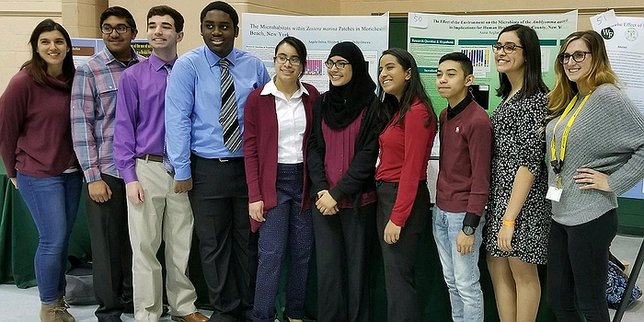Mastic Beach, NY - May 8, 2018 - Four William Floyd High School students – Farihah Chowdhury, Asma Asghar, Noah Brandi and Mariam Sheikh – have had the opportunity to work at various beamlines at the Brookhaven National Laboratory (BNL) National Synchrotron Light Source (NSLS) in an attempt to solve the unknown structure of a protein. Working with Dr. Aleida Perez, Dr. Vivian Stojanoff, Dr. Alex Soares and other scientists at the AMX, FMX and LIX beamlines, students and mentors are hypothesizing that this protein is involved in the red meat allergy that is associated with the lone star tick bite.
“The combination of these beamlines will allow for the possibility of the protein to be analyzed in its crystalline form and to analyze the protein in a solution form,” said Victoria Hernandez, science research teacher, William Floyd High School. “Since this protein is incredibly complicated and has never been resolved, doing both forms increases the chance of student success. If all goes accordingly, the ultimate goal of the students is to publish this protein in the protein data base which will aid in future medicinal research related to immune responses.”
William Floyd High School students have also been analyzing light elements within the sediments of the Forge River at BNL’s NSLS II using samples from various sites throughout the community including by Watami restaurant, the Riviera Docks and Barnes Road/Montauk Highway junction. They have been collaborating with BNL scientists and students from Eastport South Manor in data collection. “The Forge River is a staple to the William Floyd community which is why it is really important that students participate in citizen science right in their own backyards,” said Anya Swiss, William Floyd High School science teacher.
Jason Rattansingh, another William Floyd student, collected preliminary data in the fall using the same beamline, while John Hangley and Michael Borrayo are continuing data collection and analyzing more sediments. “The purpose of this project overall is to determine if historical duck farming, industrialized agriculture, and sewage runoff are impacting the health of this river,” Mrs. Hernandez added. This is done by collecting sediments, preparing them, and using tender energy absorption spectroscopy at the TES beamline at NSLS II. “This technique allows students to identify the different forms of phosphorous and sulfur along with other light elements in the sediments.”










